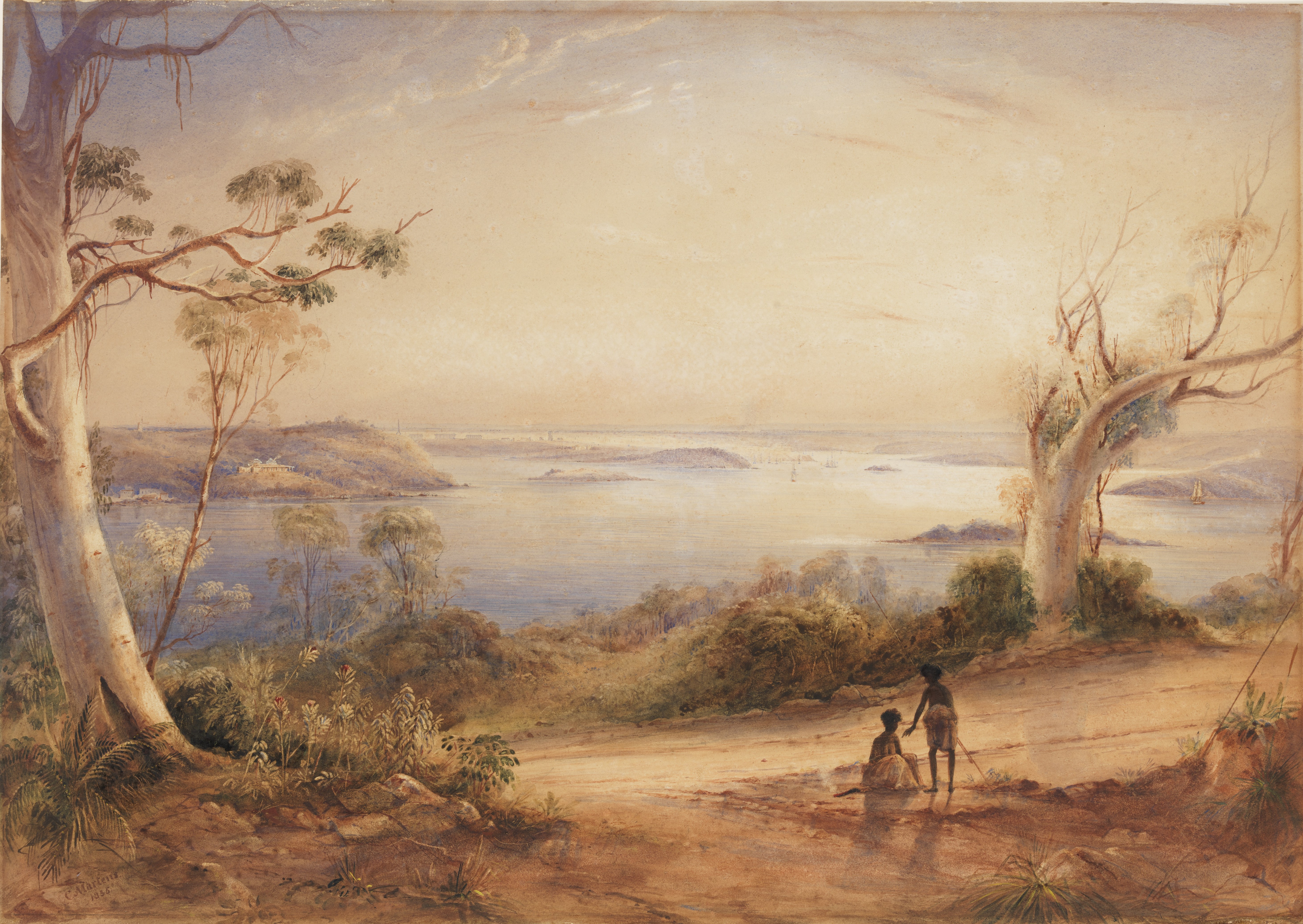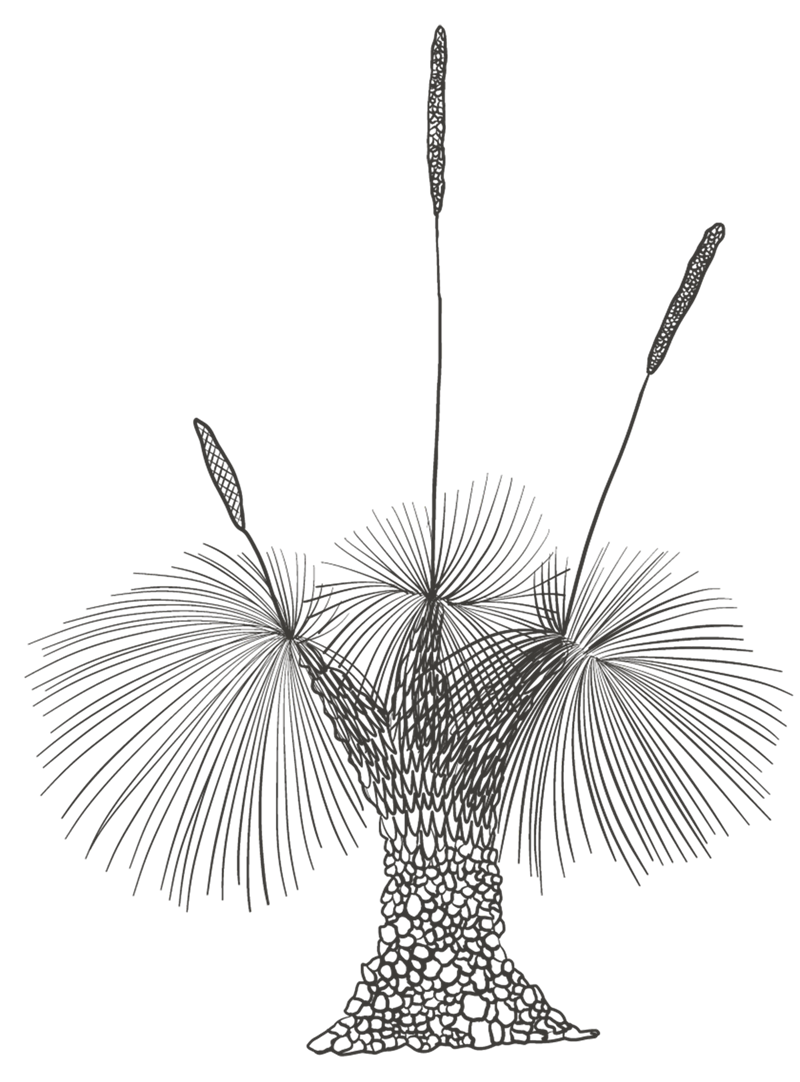When the Berewalgal (people from ‘very far’) arrived in January 1788, they began marking areas of fresh water and renaming Aboriginal land.
These mi-yal (strangers) were the people of the First Fleet, most of which were convicts, and others, government officials and naval officers and their families. After declaring Kamay (Botany Bay) unsuitable for their penal settlement a party of three small boats sailed through Port Jackson, which Governor Arthur Phillip called ’the finest harbour in the world’.1

View of Sydney Harbour, 1835
By Conrad Martens, State Library of NSW, DL 29
As the ships sailed beyond Kamay and through Port Jackson in search of a place to land, Aboriginal people were observed following the boats from their vantage points along the shores, shaking their spears and shouting ‘warra, warra, warra’ or ‘warra warra wai’. The berewalgal assumed this meant ‘go away’, however, Gweagal and Dharawal knowledge holders have since reinterpreted this encounter through the complex lens of language, culture and spirituality. 2
One Dharawal Dreaming story tells of the return of guwinj (spirit or ghost) travelling among low-lying clouds. As Dunghutti/Dharawal scientist, Dr Shane Ingrey, notes: ‘Looking at these events through a spiritual lens we came to understand some of the spiritual reasoning in interpreting those events.’3
Ray Ingrey, chairperson of the Gujaga Foundation, explains:
In Dharawal the word ‘warra’ means dead and is associated with the colour white. When we emphasise something we double the word. The suffix ‘-wai’ on the end of the warrawarra means ‘they all’, so from a Dharawal language perspective the words being said in 1770 and then 1788 mean ‘they are all dead’ and not ‘go away’.4
Read the next part of the story.
Governor Phillip to Lord Sydney, 15 May 1788, in Alexander Britton, ed., Historical Records of New South Wales (Sydney, NSW: Government Printer, 1892), 122, http://nla.gov.au/nla.obj-343658027; Jakelin Troy, The Sydney Language (Canberra, ACT: Aboriginal Studies Press, reprinted 2019), 38; Grace Karskens, The Colony: A History of Early Sydney (Sydney, NSW: Allen and Unwin, 2010), 47. ↩︎
David Collins, An account of the English colony in New South Wales: with remarks on the dispositions, customs, manners, &c. of the native inhabitants of that country. To which are added, some particulars of New Zealand… (London, UK: Printed for T Cadell Jun. and W Davies, 1798-1802), Vol I, 3 (State Library of NSW, Q79/60). Dr Shayne Williams, ‘We saw them coming’, in Eight Days in Kamay, State Library of NSW, 2020, https://www.sl.nsw.gov.au/stories/eight-days-in-kamay/chapter-1-we-saw-them-coming/2. ↩︎
Ray Ingrey, ‘Warra warra wai: Understanding Dharawal spirituality with Ray Ingrey’, Eight Days in Kamay, Gujaga Foundation, 5 May 2022, https://www.sydney.edu.au/museum/whats-on/talks-and-events/eight-days-in-kamay/warra-warra-wai--understanding-dharawal-spirituality-with-ray-in.html and Dr Shane Ingrey, ‘Voices heard but not understood’, Gujaga Foundation, 29 April 2020, https://www.gujaga.org.au/stories/voices-heard-but-not-understood. ↩︎
Ray Ingrey, Shane Ingrey, Paul Irish, Kodie Mason and Sophie Youngberry, ‘Telling our stories our way’, Endeavour Voyage: The Untold Stories of Cook and the First Australians, National Museum of Australia, https://www.nma.gov.au/exhibitions/endeavour-voyage/kamay-botany-bay/telling-our-stories-our-way. ↩︎

